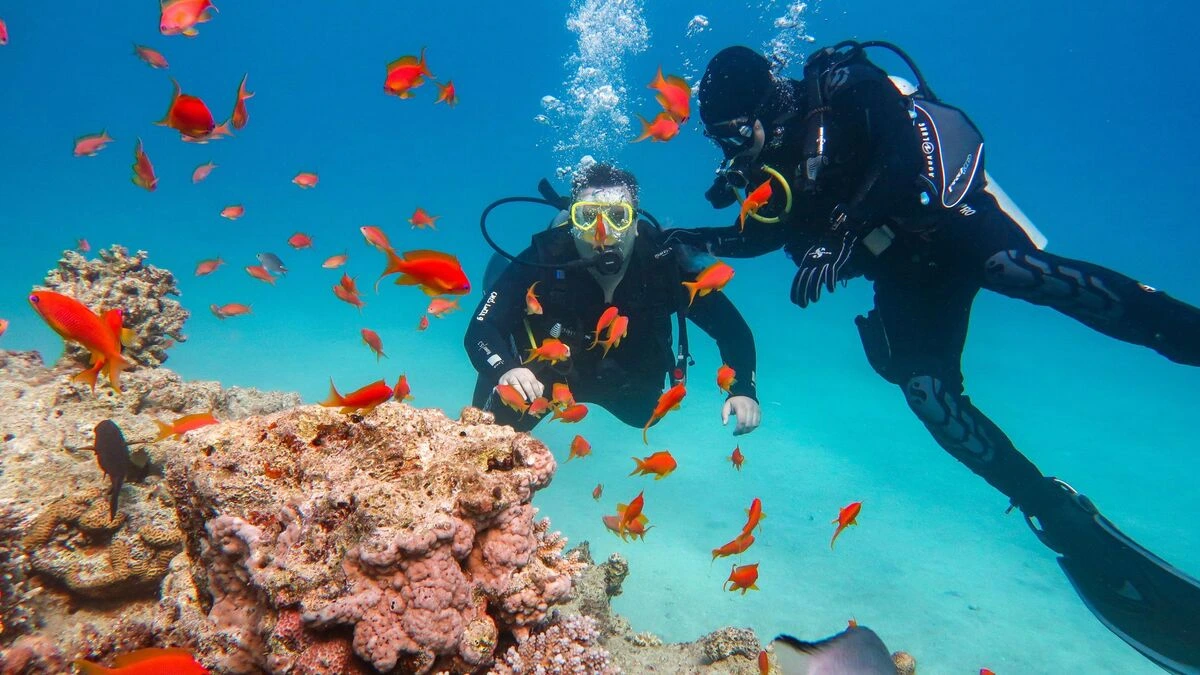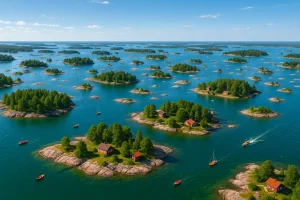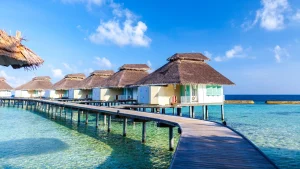Warm seas and soft drift make scuba diving in Maldives feel easy. Bright coral reefs sit close to shore, and clear water meets long lines of coral out in the Indian Ocean. Some call these waters calm, even gentle. There are spots where first‑time divers might see turtles or small reef sharks, and other places with deeper channels. Locals say the shallow lagoons bring colour even on short dives.
More guests enjoy drift dives, where the current brings bigger fish like eagle rays. Many choose resort diving. They step from sandy beaches straight into the water. Others book liveaboard diving Maldives trips. On these live aboard Maldives boats, divers sleep and eat on deck, waking near new reefs each morning. This way, even far off atolls become easy to reach. The secret behind every Maldives Honeymoon Packages is this beautiful adventure.
What makes scuba Maldives special:
- Warm water, often between twenty‑six and thirty degrees Celsius
- Clear views, with visibility often beyond twenty meters
- Calm lagoons perfect for first dives
- Drift dives for those who want gentle movement with the current
- Friendly local guides trained under global safety rules
- Mix of shallow coral gardens and deeper channels
Scuba diving in Maldives isn’t about going deep or swimming fast. It’s more about slow moves, calm water, and watching life on the reef. It invites slow breathing, quiet floating, and steady eyes. Many say the calm feels as special as the sea life. What sticks most isn’t only the view under water. It is that gentle, warm feel of the sea.
Why the Maldives is a Dream for Scuba Divers
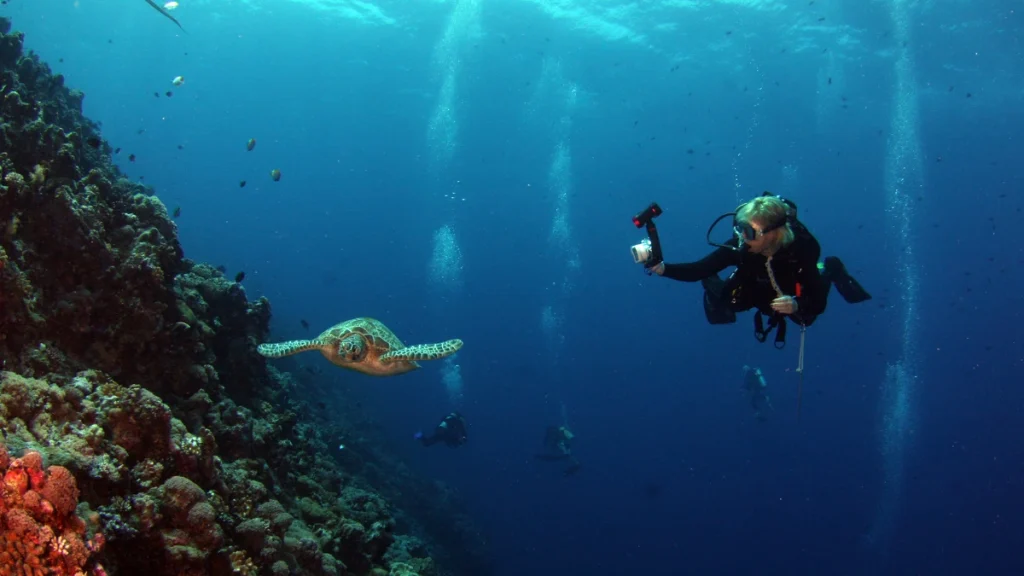
Scuba diving in Maldives feels simple, warm, and colourful. The islands lie across coral atolls that calm the water and keep sea life close to shore. Many divers visit to see bright coral, turtles, and reef sharks without deep dives. The Maldives offers both easy shallow dives and gentle drift dives.
Some travellers pick liveaboard diving Maldives trips. These live aboard Maldives boats move each night to quiet reefs. Each morning starts close to a fresh dive site, far from busy spots.
What makes scuba Maldives stand out:
- Warm sea in most months
- Clear water that often shows coral from the surface
- Soft currents that help divers move without effort
- Drift dives that bring bigger fish into view
- Dive teams trained under global safety rules
| What divers like | Why it helps |
| Clear water | See fish, rays, and coral easily |
| Warm seas | Light wetsuits, longer dives |
| Liveaboards | Reach quiet reefs each morning |
| Slow drift dives | Watch large fish without deep dives |
Scuba diving in Maldives is not about speed. It is about slow moves, gentle light, and calm breathing under water. Some visitors still talk about that quiet feel, and the sea feeling so close, even after they leave.
Best Scuba Diving Spots in Maldives

Many famous reefs and channels are offered by scuba diving in Maldives. These spots bring soft coral, reef fish, and bigger sea life into view. Some sites sit near resort islands. Others need liveaboard diving Maldives trips to reach. Each dive site has its own mood. Some stay shallow and calm. Others hold stronger currents where manta rays and reef sharks pass by. Local guides often help pick spots that fit each diver’s skill.
Popular places for scuba Maldives dives:
- Banana Reef – Bright coral walls, easy currents, and small caves
- Maaya Thila – Night dives show grey reef sharks and hunting fish
- Fish Head – Schools of snapper, barracuda, and soft coral
- HP Reef – Stronger currents bring eagle rays and big fish
- Fotteyo Kandu – Soft coral in many colours and deeper channels
Liveaboard diving Maldives trips help divers see more in one stay. Boats move overnight, so guests wake close to new reefs each day. Many say living aboard Maldives trips feel calm and simple, without daily packing or long boat rides. Scuba diving in Maldives is not only about depth or skill. It is about light, colour, and the slow float above coral gardens. Even quick dives stick with you. Fish flashing in warm, blue water, easy to remember.
What to Expect: Maldives Scuba Diving Experience
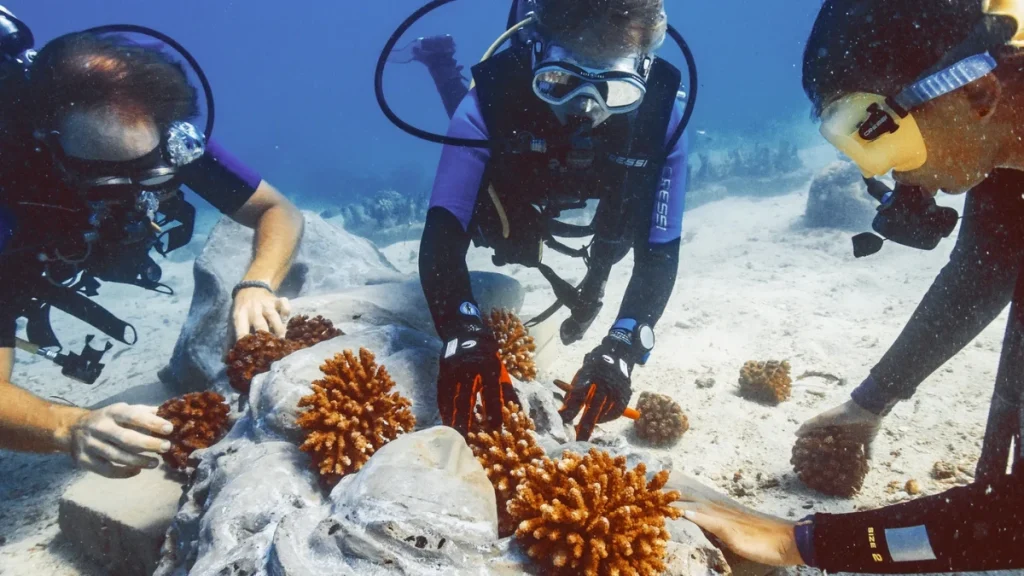
Scuba diving in Maldives often feels warm, slow, and gentle. Divers find bright coral, clear water, and fish that swim close without fear. Many sites lie near resort islands. Others sit in channels where bigger fish pass by. Most dives start from boats that ride out to reefs. Some guests pick liveaboard diving Maldives trips. These live aboard Maldives boats stop overnight near remote reefs, so mornings begin close to quiet spots.
| Part of the day | What usually happens |
| Morning | First dive near a reef or channel |
| Mid‑day | Rest, lunch, short trip to next site |
| Afternoon | Second or third dive |
| Evening | Some boats offer night dives |
Dive briefly explains where to swim, what to watch for, and how strong the current might feel. Safety checks stay simple but strict. Scuba Maldives trips stay calm. Divers move slow, watch fish glide by, and listen only to bubbles rising. Light changes during each dive, making coral look different by hour.
The Maldives does not ask for speed or big skill. Most dives fit even those with fewer logged dives. What stays in memory is the quiet, the warm water, and the bright colours under gentle light.
Beginner‑Friendly Diving in Maldives
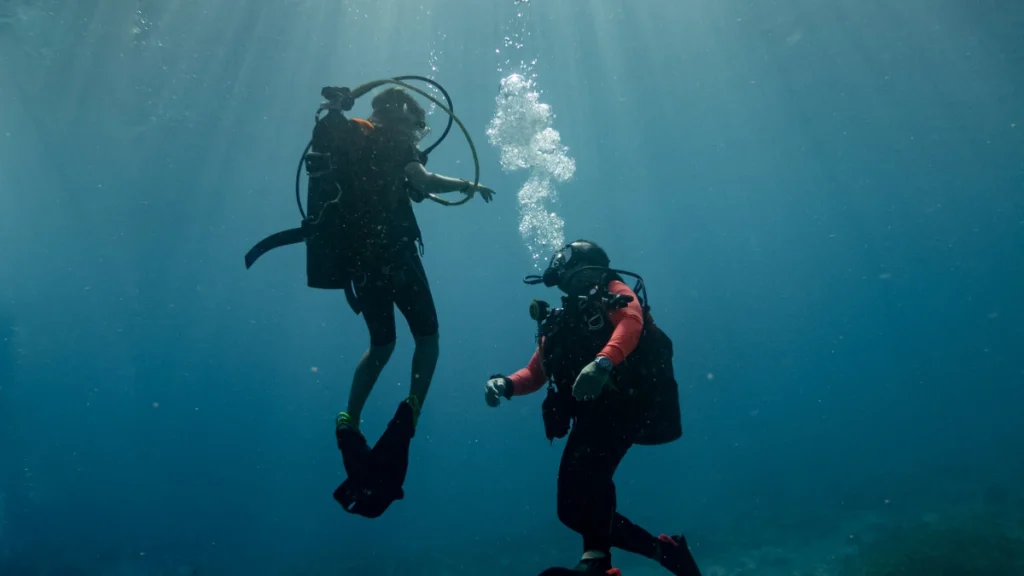
Scuba diving in Maldives often starts gently. Many reefs lie close to shore, and the water stays warm most of the year. This makes it easier for new divers to feel calm. For someone trying scuba Maldives for the first time, the steps stay simple. The instructor will explain all the gear, hand signals, and how to breathe under water. Boats leave from beaches or short jetties, so there’s no long ride.
Some spots have sandy bottoms, clear shallows, and few waves. This helps beginners feel steady and less rushed. Drift dives move slowly, letting new divers watch fish pass without swimming hard.
What helps beginners most:
- Shallow coral gardens near resort islands
- Warm water that removes shock and cold
- Clear views to spot sea life easily
- Guides trained by global dive groups
- Light wetsuits instead of heavy gear
Many first‑time guests join short courses. A common choice is a basic certification or “discover” dive. These often include pool practice and one or two sea dives with an instructor.
| Part of the beginner day | What usually happens |
| Briefing and pool time | Learn gear, signals, breathing |
| Shallow reef dive | Stay close to guide, explore slowly |
| Surface rest | Drink water, relax, check gear |
| Second dive (optional) | Practice more skills or just watch fish |
Some guests later book liveaboard diving Maldives trips once they feel sure in the water. These live aboard Maldives boats still welcome beginners, often offering easy dives on the first days. For many, the first dive in Maldives stays in memory. It’s not depth or skill that is felt most, but the calm given by the gentle sea, bright coral, and slow breathing.
Best Time to Go Scuba Diving in Maldives
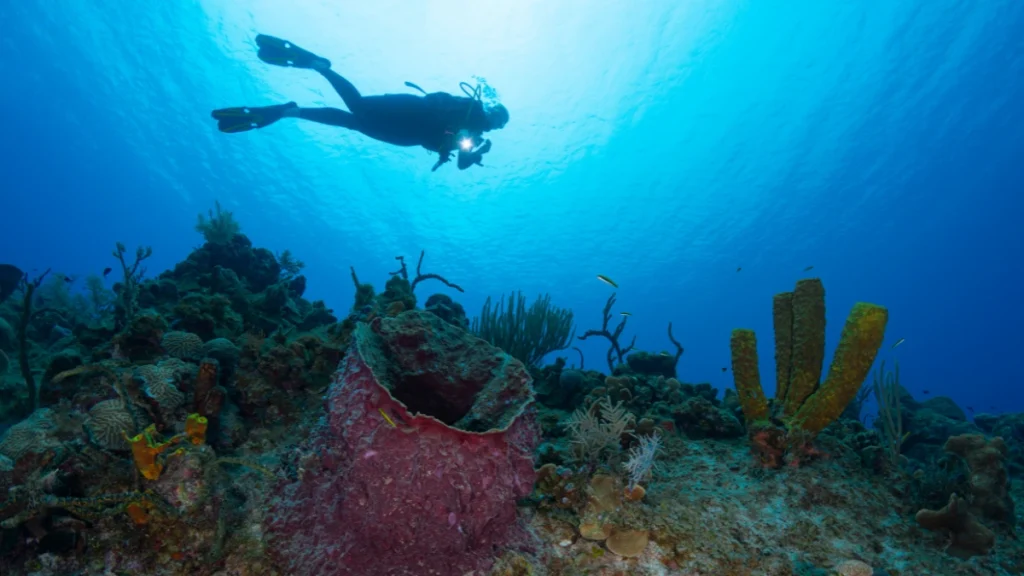
Most months are marked by warmth in the Maldives, which means scuba diving can be done nearly all year. Yet some months bring clearer water or bigger sea life. Knowing these small changes helps visitors choose when to come. From late autumn to early spring, seas stay calm and clear. Many call this the best season for scuba diving in Maldives. Visibility often stretches beyond twenty meters, and drift dives feel smooth.
Some divers come in summer. The sea might show stronger currents and short rain showers, but it also brings plankton. Plankton attracts manta rays and sometimes whale sharks. Many liveaboard diving Maldives boats plan special trips then.
Two main dive seasons:
- Dry months (roughly November to April): calmer seas, clear views, easy dives
- Wet months (roughly May to October): more plankton, bigger rays and sharks, stronger drift dives.
Local guides often suggest mornings for dives, when the light sits softer and the sea feels quiet. Afternoon dives can feel warmer but sometimes see small changes in current. Some guests pick liveaboard diving Maldives trips to move between atolls. Boats choose reefs based on weather each day, which helps divers stay close to calm spots even in wet months.
No matter the month, scuba Maldives trips stay gentle and warm. It isn’t only about what swims past but the soft light, clear water, and calm pace that make dives special. For most, the best time becomes the time they can stay slow, breathe easy, and watch the sea move.
Scuba Diving Tips for Maldives Travelers
- Drink water between dives – Warm seas can hide thirst. Staying hydrated keeps energy steady and helps avoid tiredness.
- Listen to dive briefings – Local guides know currents and reef paths. Their advice helps divers stay safe and see more.
- Pack light with soft bags – Boats have small spaces. Soft bags fit better than hard suitcases.
- Use reef‑safe sunscreen – Some lotions harm coral. Reef‑safe cream protects skin and sea life together.
- Move slowly under water – Calm kicks keep fish close. Quick moves scare sea life and stir sand.
- Avoid touching coral or chasing fish – Reefs stay healthy when divers watch without contact.
- Take a refresher dive if unsure – Even skilled divers feel better after practice, especially after months off.
- Bring a personal mask and fins if possible – Familiar gear fits better and feels more comfortable.
- Use a dive computer – Helps track depth and time safely on every dive.
- Enjoy the slow pace – Scuba diving in Maldives is less about depth and more about warm water, calm breath, and quiet views.
Liveaboard vs Resort Diving: What’s Right for You
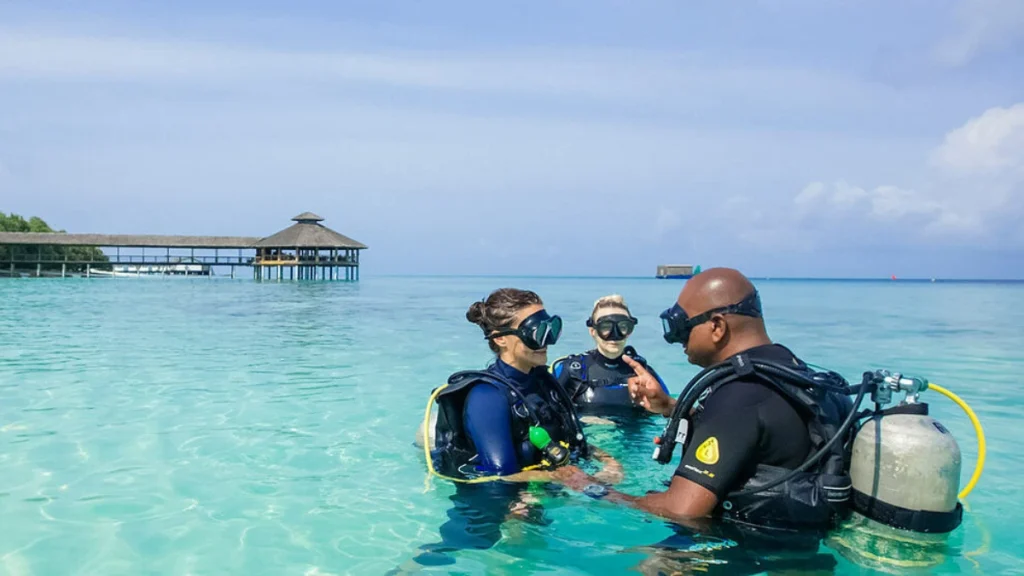
Scuba diving in Maldives can be done two main ways. Some travelers join liveaboard diving Maldives trips that move from reef to reef. Others stay at an island resort and join daily boat dives.
| What matters | Liveaboard diving Maldives | Resort diving in Maldives |
| Where you sleep | On the boat, moving to new reefs | On land, in hotel rooms or villas |
| Number of dive sites | Often higher – boat moves to far spots | Fewer – dives mostly near the island |
| Comfort on land | Smaller cabins, shared spaces | Bigger rooms, pools, restaurants |
| Daily routine | Dive–eat–rest–dive, full diving days | Mix of dives, beach walks, and free time |
| Suitcase space | Need light packing, soft bags | More room for bigger luggage |
| Good for beginners | Can work but feels busier | Easier pace, breaks between dives |
| Other island fun | Limited – mostly stay on the boat | More: spa, walks, island tours |
Live aboard Maldives trips help divers see quiet reefs early each morning. Resort stays feel steadier, with time to relax on sand after diving. Both choices keep the same heart: warm seas, coral gardens, and calm drift dives with local guides. Travelers pick what fits how they want to spend time above water.
Final Thoughts
Scuba diving in Maldives feels simple and calm. The sea stays warm most of the year, and reefs sit close to shore. Even short dives show coral and small fish. Drift dives let divers float and watch turtles or rays without rushing. Local guides know the spots.
They wake up near quiet reefs and dive early. Others stay at resorts and mix dives with walks on the beach. Both ways feel good. The best part isn’t how deep or far you go. It’s the slow breathing, the soft light under water, and that quiet moment when the reef moves around you. Scuba Maldives isn’t only about the fish you count. It’s how the sea feels warm, slow, and gentle and how that memory stays long after the trip ends and if you want to experience this then book Maldives Honeymoon Packages by Roaming Routes.
FAQ About Scuba Diving in Maldives
Q.1 Is scuba diving in Maldives fine for someone new?
Yes. Many reefs sit close, and the water feels warm most months. Guides explain each step. Even a first dive shows fish and coral without going deep.
Q.2 What is it like on liveaboard diving Maldives boats?
Simple life on water. Sleep, wake up near a new reef, dive, eat, rest. It feels calm. Some days see more sites than resorts do.
Q.3 When is the sea clearest in Maldives?
Mostly late autumn to early spring. Summer months bring plankton, which can mean manta rays and sometimes whale sharks.
Q.4 How warm is the water in Maldives?
Pretty warm most times, usually in the high twenties Celsius. Many wear short wetsuits or even just rash guards.
Q.5 Is it all deep dives?
No. Lots stay in shallow coral gardens, turtles, reef fish. Deeper dives might bring sharks or rays, but it’s not needed to enjoy it.

